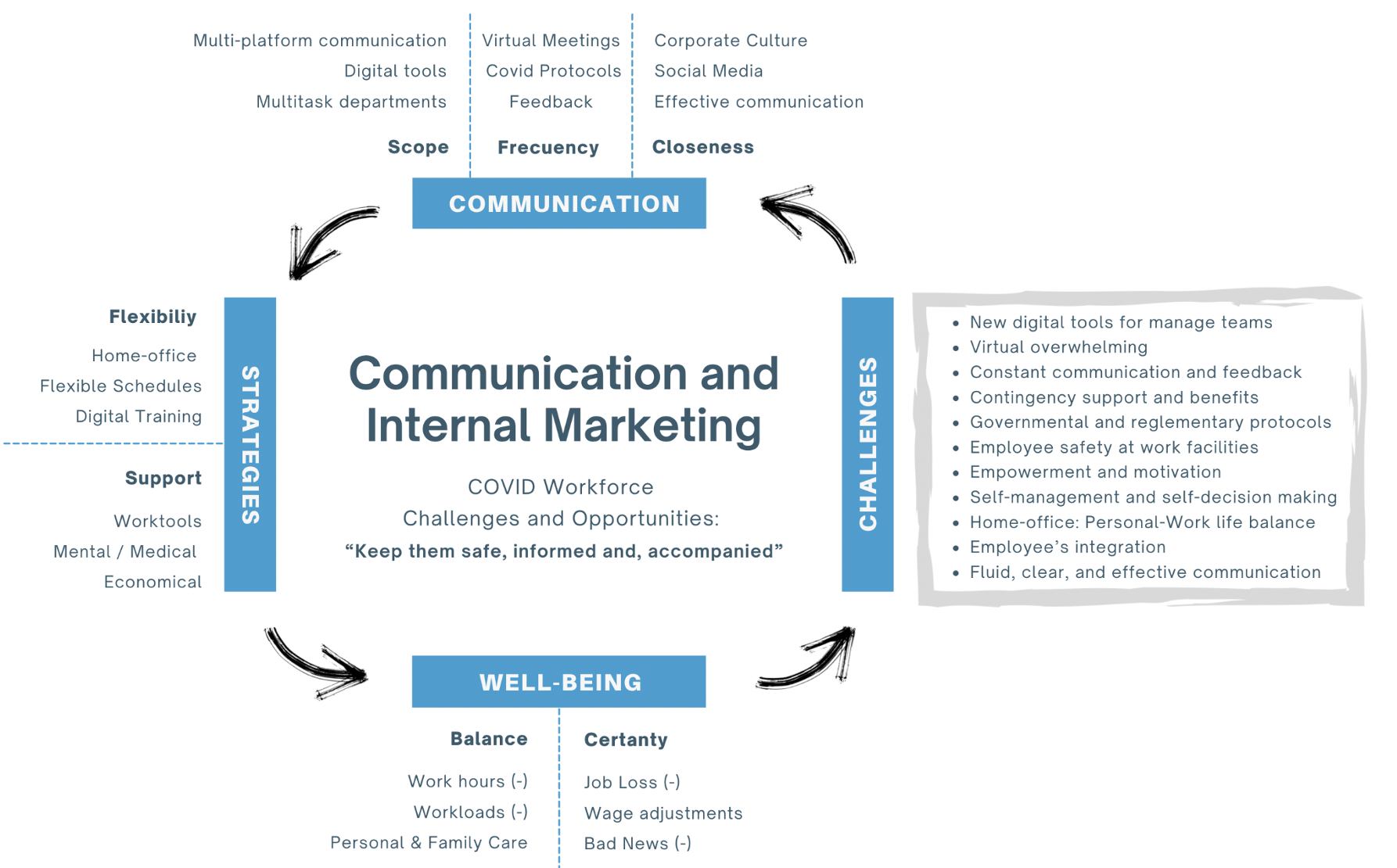Moving Forward to Face Workforce Challenges and Opportunities in the COVID-19 Era
The relevance of communication and internal marketing for employees’ emotional well-being

Since the arrival of COVID-19, companies have faced new challenges and opportunities, especially regarding how to care for and support the workforce. During the pandemic, the workforce system was in turmoil, changing the entire work dynamic for enterprises. Intuitively, companies started to identify a need to implement Internal Marketing strategies to survive the crisis and protect their employees’ emotional well-being, making them feel safe, motivated, and committed.
There is strong evidence that employees prefer to work in companies that care about them (Vasconselos, 2008), and this is where Internal Marketing comes into play. It is defined as a “planned effort using a marketing-like approach to overcome organizational resistance to change and to align, motivate and inter-functionally coordinate and integrate employees towards the effective implementation of corporate and functional strategies in order to deliver customer satisfaction through a process of creating motivated and customer-orientated employees” (Raffiq and Ahmed, 1993).
Therefore, we conducted a qualitative study to identify the most relevant challenges that companies were facing during the COVID-19 contingency and how top-level managers coped with them. This study was focused on understanding the employer’s perspective about four main topics through seven in-depth interviews conducted with CEOs of SMEs in different industries in Mexico:
- Internal Marketing Communications Implications
One of the major changes in the new work dynamics is that “employees have communicated more closely”. There is a greater emphasis on internal communication, guaranteeing fluid, clear, and effective communication. Some of the comments highlight more frequent and closer internal communication with employees, despite home office and the internal policies for working under this format. There is also the integration of multi-platform communication using digital tools, such as social media (Whatsapp, Facebook), Zoom, Meet, Google Drive, newsletters, among others.
Companies have also implemented other strategies related to internal marketing communications during this contingency:
- Virtual meetings for tracking projects, job performance, and KPIs, as well as employee integration dynamics
- Campaigns for adopting COVID-19 protocols, and explaining how employees can be safe from the virus
- Multitask departments, with each area learning tasks from other areas to provide support when needed, as a result of job dismissals
- Scripts and actions to maintain the corporate culture, brand essence, and brand image
- Social media branding to be closer to external customers
- Internal Marketing Strategies Developed for the Contingency
Employers recognized that the focus during the contingency is on providing support so that employees can keep their jobs and salaries”. Some changes in the new work environment are the home office schemes, flexible schedules, reduced working hours, and optional in-person attendance in the workplace. One focus has been on training employees in the use of digital tools, multitasking activities, and, especially, at the front desk for customers and suppliers.
Some companies are also giving support with office equipment and workstations (e.g., computers, desks, monitors, internet service, cellphones), as well as other facilities such as mental health care (i.e., access to psychologists for employees and their families), medical support (i.e., access to medical consultations for employees and their families and access to COVID-19 tests, or financial support for taking the test), personal protection equipment for COVID-19 (e.g., mouth covers, masks, gloves, antibacterial gel), sanitization areas at the work facilities and workstations, access to nearby coworking spaces and transportation services (to avoid the use of public service), and help to buy groceries and provisions.
In this aspect, a priority for companies is to help people keep their jobs and protect them from infection. However, in a complicated and uncertain situation such as COVID-19, not having to close down the business is enough.
- Employees’ Emotional Well-being
If we look back, we will realize that “people are tired of being in quarantine”, making this a key relevant aspect regarding employees’ emotional well-being. In this sense, the interviews reveal that:
- Executives are working more hours from their homes vs offline work
- Job uncertainty predominates (employees are fearful of losing their jobs)
- Employees are being affected in their wages (there is a lower income, because of a lower financial performance in enterprises); in fact, some companies have made wage adjustments, lowering them to keep the enterprise alive and to promote productivity (e.g. variable wages)
- Employees are tired and unmotivated. However, a relevant insight is that young people have adapted better than older ones to be more productive
The emotional well-being of employees during the contingency has been negatively affected and is not optimal. Some enterprises report that their employees are trying to keep calm by doing occupational therapy and avoiding news overexposure that generates fear. In contrast, other companies have implemented personal care-related practices (e.g., birthday cakes sent to the employees’ homes, so they could celebrate with their families). A key takeaway is that little details can make the difference between making our employees feel good or bad.
- Main Challenges of the COVID-19 Contingency
The interviewed employers concluded that during a contingency the best way to support employees is to “keep them safe and informed”. Taking advantage of technology, the contingency has brought new and different digital tools for meetings, communication, tracking projects, and monitoring performance and KPI’s. However, the most relevant challenges include:
- Constant communication and feedback for employees
- Communication to ensure that all employees know about their access to contingency support and benefits
- Government and regulatory protocols for working during the COVID-19 contingency
- Employee safety from COVID-19 in the workplace
- Empowerment and motivation, so employees can feel they are essential to the organization
- Self-management and self-decision making (before COVID-19, employees were directed by their superiors, now they are on their own most of the time)
- Personal-Work life balance (since homeworking implies common family interruptions, punctuality problems, distractions, obstacles)
- Employee integration (because of the number of personal and job activities employees face every day, there is very little time for attending social meetings)
- Communication is still a big challenge (even though today communication is closer and more frequent than ever)

Ultimately, it is evident that the COVID-19 contingency has changed work dynamics and organizations are facing important challenges to maintain effective communication with their employees to keep them motivated, with optimal emotional well-being, to support them and make them feel accompanied, and protecting them from infection. Therefore, internal marketing must be enabled in organizations to attend and to solve these challenges.
Although it seems we are near the end of the contingency, companies are still struggling with the effects of the changes in the work environment, and the changes they were facing at the beginning of the pandemic are still on the table. Companies need to move agilely in implementing strategies and providing protocols to keep employees safe and motivated whenever a crisis comes knocking at the door.
References:
Rafiq, M., & Ahmed, P. K. (1993). The scope of internal marketing: defining the boundary between marketing and human resource management. Journal of marketing management, 9(3), 219-232.
Vasconcelos, A. F. (2008). Broadening even more the internal marketing concept. European Journal of Marketing, 42(11/12), 1246-1264
“The Role of Internal Marketing During the COVID-19 Crisis” will be published as a chapter in the book “Marketing by Contingency” by Apple Academic Press 2021.
The qualitative research article is in the process of being published.
The authors are Consultant and Adjunct Professor, Department of Marketing and Analysis, Tecnológico de Monterrey, Campus Monterrey (Nancy Guerra) and MBA Director, EGADE Business School Monterrey, and Director of the EGADE-UNC Charlotte MBA in Global Business & Strategy (Eva M. Guerra-Leal).




